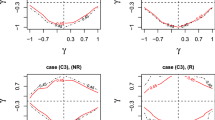Abstract
A direct method in handling incomplete data in general covariance structural models is investigated. Asymptotic statistical properties of the generalized least squares method are developed. It is shown that this approach has very close relationships with the maximum likelihood approach. Iterative procedures for obtaining the generalized least squares estimates, the maximum likelihood estimates, as well as their standard error estimates are derived. Computer programs for the confirmatory factor analysis model are implemented. A longitudinal type data set is used as an example to illustrate the results.
Similar content being viewed by others
References
Afifi, A. A., & Elashoff, R. M. (1967). Missing observations in multivariate statistics—II: Point estimation in simple linear regression.Journal of the American Statistical Association, 62, 10–29.
Afifi, A. A., & Elashoff, R. M. (1969). Missing observations in multivariate statistics—III: Large sample analysis of simple linear regression.Journal of the American Statistical Association, 64, 359–365.
Anderson, T. W. (1957). Maximum likelihood estimates for a multivariate normal distribution when some observations are missing.Journal of the American Statistical Association, 52, 200–203.
Bentler, P. M. (1980). Multivariate analysis with latent variables: Causal modeling.Annual Review of Psychology, 31, 419–456.
Bentler, P. M. (1983). Some contributions to efficient statistics in structural models: Specification and estimation of moment structures.Psychometrika, 48, 493–517.
Brown, C. H. (1983). Asymptotic comparison of missing data procedures for estimating factor loadings.Psychometrika, 48, 269–291.
Browne, M. W. (1974). Generalized least squares estimators in the analysis of covariance structures.South African Statistical Journal, 8, 1–24.
Browne, M. W. (1984). Asymptotic distribution-free methods for the analysis of covariance structures.British Journal of Mathematical & Statistical Psychology, 37, 62–83.
Chan, L. S., & Dunn, O. J. (1972). The treatment of missing values in discriminant analysis—1. The sampling experiment.Journal of the American Statistical Association, 69, 473–477.
Dempster, A. P., Laird, N. M., & Rubin, D. B. (1977). Maximum likelihood from uncomplete data via the EM algorithm (with Discussion).Journal of Royal Statistical Society (B),39, 1–38.
Findbeiner, C. (1979). Estimation for the multiple factor models when data are missing.Psychometrika, 44, 409–420.
Hocking, R. R., & Smith, W. B. (1968). Estimation of parameters in the multivariate normal distribution with missing observations.Journal of the American Statistical Association, 63, 159–173.
Hocking, R. R., & Marx, D. L. (1979). Estimation with incomplete data: An improved computational method and the analysis of nested data.Communication in Statistics (A),8(12), 1155–1181.
Jöreskog, K. G. (1978). Structural analysis of covariance and correlation matrices.Psychometrika, 43, 443–477.
Jöreskog, K. G., & Sörbom, D. G. (1977). Statistical models and methods for analysis of longitudinal data. InLatent variables in socio-economic moels (Ed.), D. J. Aigner & A. S. Goldberger (pp. 285–325). Amsterdam: North Holland Publishing.
Kshirsagar, A. M. (1959). Barlett decomposition and Wishart distribution.Annals of Mathematical Statistics, 30, 239–241.
Lawley, D. N., & Maxwell, A. E. (1971).Factor analysis as a statistical method (2nd ed). New York: American Elsevier.
Lee, Sik-yum, & Jennrich, R. I. (1979). A study of algorithms for covariance structure analysis with specific comparisons using factor analysis.Psychometrika, 44, 99–113.
Szatrowski, T. D. (1983). Missing data in one-population multivariate normal patterned mean and covariance matrix testing and estimation problem.Annals of Statistics, 11, 947–958.
Werts, C. E., Linn, R. L., & Jöreskog, K. G. (1978). Reliability of college grades from longitudinal data.Educational and Psychological measurement, 38, 89–95.
Wheaton, B., Muthén, B., Alwin, D., & Summers, G. Assessing reliability and stability in panel models. In D. R. Heise (Ed.):Sociological Methodology, 1977, San Francisco: Joseey-Bass, 1977, 84–136.
Wilks, S. S. (1932). Moments and distributions of estimates of population parameters from fragmentary samples.Annals of Mathematical Statistics, 3, 163–195.
Author information
Authors and Affiliations
Additional information
This research was supported in part by Research Grant DAD1070 from the U.S. Public Health Service. The author is indebted to anonymous reviewers for some very valuable suggestions. Computer funding is provided by the Computer Services Centre, The Chinese University of Hong Kong.
Rights and permissions
About this article
Cite this article
Lee, SY. Estimation for structural equation models with missing data. Psychometrika 51, 93–99 (1986). https://doi.org/10.1007/BF02294002
Received:
Revised:
Issue Date:
DOI: https://doi.org/10.1007/BF02294002



